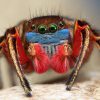I am a visual ecologist studying animal perception, cognition and behavior. My research interests are centered around the ways in which animal systems perceive the world around them – specifically, how perceived reality aligns or misaligns with physical reality. Pragmatic sensory systems often use cognitive shortcuts to save time and energy, creating perceptual realities that are useful rather than accurate. For visual systems, the shortcomings of such shortcuts are exposed in high relief by visual illusions. I am especially interested in studying how visual illusions have evolved to exploit the perceptual reality of receivers to the benefit of signalers on morphological, psychophysical and ecological scales. My dissertation work in the Morehouse lab explores color perception, sensory exploitation and signaling ecology in jumping spiders. Through modeling and behavior, this work allows me to indulge in my love of designing and building novel equipment for behavioral applications. When I am not exploring alternate realities with jumping spiders, I enjoy working with community partners to increase scientific accessibility through outreach programs and activism.
2018-present Ph.D. student, Biological Sciences, University of Cincinnati, OH
2014-2018 B.S. Biology and Psychology, University of South Carolina, SC





